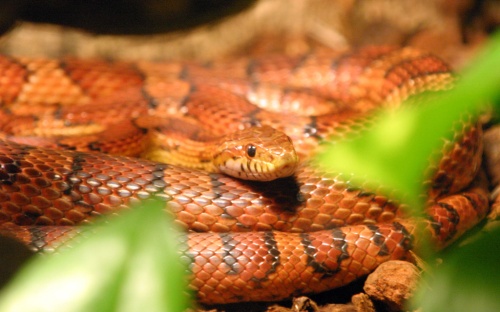Data:
Life-span: 15-20 years
Adult size: 4-5 feet long
Housing:
Corn snakes should be kept in a vivarium, allowing a minimum of one square foot of floor space for every foot of the snake’s length, and should be at least one third of the snake’s length in height. Tight-fitting lids which can be clamped down are essential. Hatchlings should be kept in an appropriately sized vivarium, as they may become stressed and stop feeding in an oversized one. With regular spot cleaning, a full clean of the vivarium should only be necessary every 3-5 weeks.
Furniture:
A hide box is essential, as your corn snake may become stressed if it is not. This should be just large enough for the corn snake to curl up inside. Too large and the snake will feel insecure. There should ideally be one hide spot in the warm side of the vivarium, and one in the cold side. Branches, rocks and plastic plants should be provided for climbing and resting. They can also aid in shedding. Branches and rocks found outside should first be washed in a chlorine/water solution, rinsed and soaked in clean water and left to dry in the sun before use. Alternatively bake in the oven for an hour at 100 degrees Celsius. Change the layout of the furniture occasionally for enrichment.
Floor covering:
Suitable floor coverings include aspen shavings (Cedar or redwood should not be used, as they are toxic), layers of newspaper or artificial grass. Coco/orchid bark should be avoided for corn snakes, as it retains too much humidity. Dirty bedding should be cleaned or removed and replaced as quickly as possible. All shavings should be removed and replaced at least once a month.
Temperature:
The vivarium should provide a temperature gradient ranging from 70-86 degrees (21-30 degrees Celsius). A heat mat with a thermostat may be placed under one third to one half of the vivarium to provide this. Alternatively a light bulb attached to the roof of the vivarium with a dimming stat. Make sure the corn snake is unable to come into come into contact with the bulb or it may burn itself. A heat mat is better, as a bulb should only be left on for normal daylight time. A maximum – minimum thermometer should be kept at the height of the snake. If a simple thermometer is used and read in the mornings and evenings, then it is possible that the temperature in the vivarium is dropping to dangerous lows in the middle of the night or getting excessively hot in the middle of the day, despite normal readins when the thermometer is checked. Relative humidity should be between 30-70% (towards the higher end during shedding).
Lighting:
Corn snakes do not require special lighting, but any lights should mimic normal daylight patterns to prevent the snake becoming stressed.
Feeding:
Corn snakes feed on mice appropriate to their size. Each mouse should be approximately the same width as one and a half times the size of the corn snake’s head. Hatchlings should be fed one pink mouse every 5-6 days, gradually increasing to one adult mouse every 7-14 days for an adult. Large corn snakes may require 2 mice. Chicks and fertilized quail eggs may also be fed, but are not recommended as a staple diet. Never feed live prey as it may bite your snake. It is best to feed your corn snake outside the vivarium to ensure no flooring is ingested.
Drinking:
Corn snakes require fresh water each day. This should be provided in a heavy bowl to prevent the snake tipping it over. The snake may also bathe in the water to aid with shedding. If your corn snake defecates in the water bowl, clean and disinfect it immediately.
Shedding:
Corn snakes shed the outer layer of their skin on a regular basis. Often they will not eat while doing so. The first sign will be areas of skin that are lighter than the rest and peel off if rubbed. The skin comes off from areas of friction first and often the smaller tips of toes and tail-end are the last to loose their skin. If the humidity is too low or their is nothing against which the snake can rub, the skin may not be fully shed. Retained skin can cut off the blood supply to toes or tail and retained ‘spectacles’ of skin over the eyes can cause problems. If necessary, help your snake by bathing it in a bowl of tepid water daily and gently easing the retained skin off with an ear-bud.


Reblogged this on Flying Mice Pet Advice.